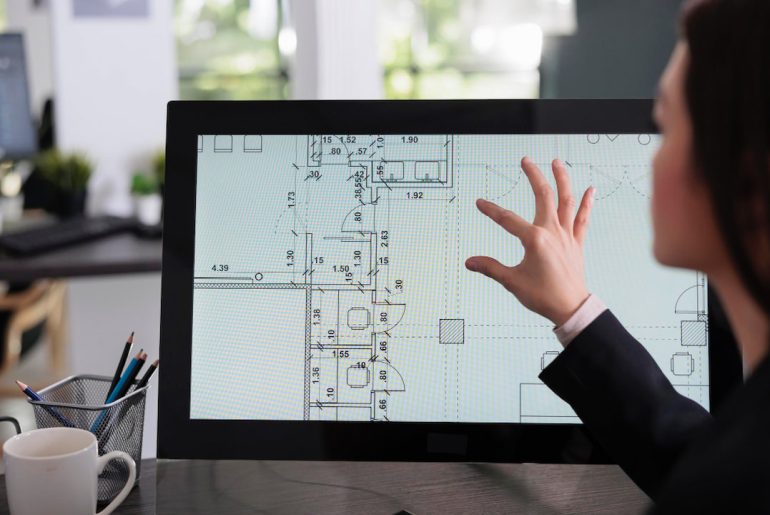AutoCAD, a powerful software application developed by Autodesk, is a computer-aided design (CAD) field that has seen groundbreaking changes since its start in the early 1980s. Gain a deep understanding of AutoCAD with the help of this thorough guide, covering its origins, key features, diverse applications across industries, and advanced tips for proficient usage. Whether you are new to AutoCAD or seeking to enhance your current skills, this article will provide you with all the essential information you need to know about this indispensable tool in the world of design and engineering.
What is AutoCAD?

AutoCAD, developed by Autodesk, is a versatile design software engineered specifically for the architecture, engineering, and construction sectors. The platform enables users to craft exact 2D and 3D diagrams with various tools and functions that enhance the efficiency of the design process. Designers can easily manipulate shapes, dimensions, and objects and annotate and label drawings with text, dimensions, and symbols. With advanced functionalities like parametric drawing and custom programming through its API, AutoCAD is essential for efficiently creating detailed designs and drawings.
Importance of AutoCAD in various industries
AutoCAD is a crucial tool in multiple industries for its precision, versatility, and efficiency. Engineering and architecture allow professionals to create detailed 2D and 3D designs, improving accuracy and team communication. In manufacturing, it helps create technical drawings, schematics, and prototypes, streamlining production processes and reducing errors. Architects use AutoCAD to visualize building plans, identify issues beforehand, and ensure projects meet regulations. Its importance cannot be overstated, as it revolutionizes how industries design, develop, and deliver products and services efficiently.
Also read: AutoCAD shortcuts for professionals
What is AutoCAD? History and evolutions
Have you ever wondered where AutoCAD originated and how it evolved into today’s powerhouse? Let’s trip down memory lane to uncover its origins and the milestones that shaped its development.
Origins of AutoCAD
AutoCAD didn’t just magically appear one day; it was born in the ’80s when shoulder pads and big hair were all the rage. This software, Created by Autodesk, revolutionized how designers could bring their ideas from concept to digital reality.
What is AutoCAD milestones in development
Like a fine wine, AutoCAD has aged gracefully over the years, with each version adding new features and capabilities that make designers’ lives easier. From its humble beginnings to the powerhouse it is today, AutoCAD has come a long way, baby!
What is AutoCAD? Key features and capabilities
AutoCAD isn’t just a one-trick pony; it’s packed with features that make designing a breeze. Let’s explore some standout tools and customization options that set AutoCAD apart.
2D and 3D design tools
Whether sketching out a floor plan or modeling a complex 3D structure, AutoCAD has the tools to help you bring your design vision to life with precision and finesse.
Also read: Discovering BIM Architecture
Options for customization
Why compromise with a standard solution when you can customize your design software to cater to your specific requirements?AutoCAD allows users to customize settings and shortcuts and even create their commands, making it a personalized powerhouse for designers.
Industries and applications of AutoCAD
AutoCAD isn’t just for doodling stick figures; it’s a versatile tool used across various industries to create everything from intricate building designs to precise engineering drawings. Let’s explore some of the critical sectors where AutoCAD shines.
Architecture and construction
Architects love AutoCAD for its ability to turn their creative visions into detailed blueprints, allowing them to design everything from cosy cottages to futuristic skyscrapers quickly and precisely.
Engineering and manufacturing
Engineers and manufacturers rely on AutoCAD to create detailed plans for everything from mechanical parts to complex machinery. With its precise measurements and design tools, AutoCAD helps bring innovative ideas to life in the engineering and manufacturing world.
So, there you have it a crash course in AutoCAD. Show off your design software skills at the next social event and amaze your friends.
How to get started with AutoCAD
So, you’ve decided to dive into the exciting world of AutoCAD. Good for you! But where do you start? Well, first things first – you need to install and set up the software. No, you can’t just wish it into existence; you must put in some effort. Don’t worry; it’s not rocket science. Once you follow the installation instructions, you’ll be running in no time.
Installing and setting up AutoCAD

Here are 8 steps to install & set up AutoCAD.
1. Obtain AutoCAD
Visit Autodesk’s official website or an authorized reseller to acquire the AutoCAD software.
2. Download the installer
Download the AutoCAD installer from the Autodesk website or the source you obtained it from.
3. Run the installer
Double-click on the downloaded installer file to start the installation process.
4. Follow on-screen instructions
Follow the on-screen instructions provided by the installer. This typically involves accepting the license agreement, selecting the installation location on your computer, specifying license details if required (such as a serial number or a license file), and choosing the components to install (such as AutoCAD, additional libraries, or language packs).
5. Complete installation
Wait for the installer to finish installing AutoCAD on your computer.
6. Launch AutoCAD
Launch AutoCAD from your computer’s programs or applications menu once the installation is complete.
7. Set preferences
Upon launching AutoCAD, you can set up your preferences according to your needs. This includes customizing the workspace layout, selecting units of measurement, setting default templates for drawings, and adjusting other settings to suit your workflow.
8. Access documentation and tutorials
Take advantage of Autodesk’s comprehensive documentation and tutorials to familiarize yourself with AutoCAD’s features and functionality and learn how to use the software efficiently for your design and drafting tasks.
Essential tools and functions
Once you’re set up, it’s time to familiarize yourself with AutoCAD’s essential tools and functions. These are like the ABCs of the software, the building blocks of your design dreams. Drawing lines, shapes, and text, modifying objects, and navigating through your project are AutoCAD’s bread and butter. Don’t worry; you’ll get the hang of it quickly. Practice makes perfect, after all.
Advanced tips and tricks for users
Now that you’ve got the hang of the basics let’s kick it up with some advanced tips and tricks for all of your AutoCAD fans out there.
Efficient drawing techniques
Time is money. So, let’s talk about efficient drawing techniques in AutoCAD. From using shortcuts and commands to setting up templates and creating blocks, there are plenty of ways to speed up your workflow and impress your colleagues. Always aim to work intelligently rather than simply exerting more effort.
Utilizing AutoCAD plugins and add-ons
Why settle for vanilla when you can have sprinkles on top? AutoCAD plugins and add-ons are like the cherry on your design sundae – they can enhance functionality, automate tasks, and take your projects to the next level. Whether for rendering, analysis, or productivity, there’s a plugin for almost everything. So, go ahead, explore, and find the ones that make your life easier.
What is AutoCAD technology future trends
Ah, the crystal ball of AutoCAD – what does the future hold for this beloved software? Let’s take a sneak peek into what’s on the horizon.
Integration with virtual reality and augmented reality
Imagine stepping inside your CAD model, walking through your designs, and experiencing them in virtual reality. It sounds like something out of a sci-fi movie. With virtual and augmented reality integration into AutoCAD, this futuristic dream is becoming a reality. Get ready to immerse yourself in your creations like never before.
Automation and artificial intelligence in AutoCAD
Are robots taking over the world? Not quite. But automation and artificial intelligence are revolutionizing the way we work with AutoCAD. From generating designs based on parameters to detecting errors and optimizing workflows, AI is here to simplify our lives and make us more efficient designers. So, embrace the bots – they’re here to help.
There you have it – a glimpse into the exciting world of AutoCAD, from getting started to peeking into the future. So, unleash your creativity, and let AutoCAD be your trusty sidekick in the design world.
Conclusion
AutoCAD continues to be a cornerstone in design and drafting, offering unparalleled capabilities and endless possibilities for creating intricate digital designsAs technology continues to advance, new features are constantly being unveiled, staying informed and continually honing one’s skills in AutoCAD will be crucial for professionals in various fields. Embrace the power of AutoCAD to streamline your workflows, unleash your creativity, and stay ahead in the ever-evolving landscape of design technology.
Frequently asked questions about what is AutoCAD
1. What is the difference between AutoCAD and AutoCAD LT?
AutoCAD is a comprehensive design and drafting software with advanced 3D modeling capabilities, while AutoCAD LT is a simplified version primarily focused on 2D drafting and lacks some advanced features.
2. Is modeling in 3D using AutoCAD possible?
3D modeling is possible with AutoCAD, as it offers robust tools and features for creating and editing 3D designs.
3. Is AutoCAD suitable for beginners without prior design experience?
Due to its complexity, AutoCAD can be challenging for beginners without prior design experience, but it provides extensive tutorials and resources to help new users learn the software.
4. Are there any free resources available for learning AutoCAD?
Yes, free resources, such as online tutorials, forums, and Autodesk’s learning platform, are available for learning AutoCAD.






